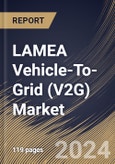The implications of V2G extend far beyond energy management. At its essence, V2G embodies a paradigm shift in how the perceive and interact with transportation and energy infrastructure. It represents a holistic approach to sustainability, where the synergies between transportation electrification and renewable energy integration are leveraged to drive positive environmental, economic, and societal outcomes.
Developing advanced bidirectional charging infrastructure is a key trend in the market. Innovations in charging technology, such as bi-directional inverters and smart charging stations, enable seamless communication and power exchange between EVs and the grid, unlocking new opportunities for V2G applications. Grid integration and smart grid solutions are crucial in enabling V2G deployment at scale. By integrating with distribution networks, grid management systems, and energy markets, V2G systems can deliver grid services, including demand response, peak trimming, and frequency regulation, thereby enhancing the stability and dependability of the grid.
Likewise, the number of growing initiatives in Dubai's EV industry provides a growth environment for the market. According to the International Trade Administration (ITA), Dubai's electric vehicle landscape is significantly expanding. The estimated number of EVs in Dubai was around 7,331 in 2023, with projections indicating a rise to 12,852 by 2025. This aligns with Dubai's Green Mobility Strategy 2030, which outlines ambitious targets, stipulating that 30% of public sector vehicles and 10% of total vehicle sales in the region should be electric and hybrid by 2030. In conclusion, the growing prevalence of EVs and the high production of automobiles drive the market's growth.
The Brazil market dominated the LAMEA Vehicle-To-Grid (V2G) Market by Country in 2022, and would continue to be a dominant market till 2030; thereby, achieving a market value of $319.2 Million by 2030. The Argentina market is showcasing a CAGR of 27.3% during (2023 - 2030). Additionally, The UAE market would register a CAGR of 26.1% during (2023 - 2030).
Based on Technology, the market is segmented into Power Management and Software. Based on Vehicle Type, the market is segmented into Battery Electric Vehicles, Plug In Hybrid Electric Vehicles, and Fuel Cell Vehicles (FCVs). Based on Charging Type, the market is segmented into Unidirectional Charging and Bidirectional Charging. Based on Component, the market is segmented into Electric Vehicle Supply Equipment (EVSE), Smart Meters, Home Energy Management (HEM), and Others. Based on countries, the market is segmented into Brazil, Argentina, UAE, Saudi Arabia, South Africa, Nigeria, and Rest of LAMEA.
List of Key Companies Profiled
- ABB Group
- Denso Corporation
- Hitachi, Ltd.
- Honda Motor Co. Ltd.
- Indra Sistemas, S.A.
- Nissan Motor Co., Ltd
- NRG Energy, Inc.
- Toyota Industries Corporation
- Fermata Energy
- Wallbox N.V.
Market Report Segmentation
By Technology- Power Management
- Software
- Battery Electric Vehicles
- Plug In Hybrid Electric Vehicles
- Fuel Cell Vehicles (FCVs)
- Unidirectional Charging
- Bidirectional Charging
- Electric Vehicle Supply Equipment (EVSE)
- Smart Meters
- Home Energy Management (HEM)
- Others
- Brazil
- Argentina
- UAE
- Saudi Arabia
- South Africa
- Nigeria
- Rest of LAMEA
Table of Contents
Companies Mentioned
- ABB Group
- Denso Corporation
- Hitachi, Ltd.
- Honda Motor Co. Ltd.
- Indra Sistemas, S.A.
- Nissan Motor Co., Ltd
- NRG Energy, Inc.
- Toyota Industries Corporation
- Fermata Energy
- Wallbox N.V.








